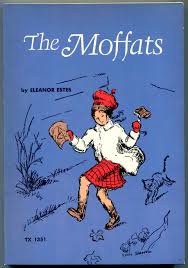Eleanor Estes
Listen to the Recess! Clip
| Author | Rita Smith |
| Air Date | 5/9/2005 |

Eleanor Estes Transcript
Eleanor Estes, born May 9, 1906, wrote books for children for over 45 years, up to her death in 1988, but it is her early books, particularly those about the Moffat family, published in the early 1940’s, that remain her most popular work.
The Moffats, The Middle Moffat, and Rufus M all chronicle the life of Sylvie, Joe, Jane, and Rufus, the Moffat children, whose family life parallels the one Estes herself led as a child. She was the third of four children with a mother, like the Moffat’s mother, who was a widowed dressmaker.
The books relate child life as experienced by one family in the 1910’s, with stories about the first day of school, ruining Sunday best clothes, dancing lessons, and being quarantined during an outbreak of scarlet fever. It is Estes’ ability to immerse the reader in the perceptions, thoughts and experiences of children make the stories resonate with familiarity and give the reader a sense of shared experience.
One day, for example, nine year old Jane is sitting idly in front of her house when the grocery man drives up with his horse and wagon, picks up the grocery bags and goes into the neighbor’s house. Jane looks at the horse for a long time. “He has wings,” she dreams, “and can carry me away. He is the wooden horse of Troy and, at any moment, many men will step out of him. He is a bridge that I can walk under. H-m-m-m-m.” Jane muses. “The horse is a bridge for me to walk under, and I’m going to walk under it.” She rises from the curb and walks under the horse just as her mother looks out the window. “Jane!… You mustn’t walk under horses. They might kick or start walking or something.” Jane steps thoughtfully up the walk. “All right, Mama,” she responds. “[Jane] had no desire to keep on walking under horses,” Estes explains, “It was just something she felt she had to do at that moment, just that once….so she had walked under him and from the feeling inside of her, she thought it had turned out to be an all right sort of thing to do.”1 In another episode, a little neighbor boy, Hugie Pudge, doesn’t want to go to the first day of school, but Rufus Moffat reaches his hand out to the shy little boy and says reassuringly, “Everybody has to go to school…Even God had to go to school.”2 Critic Virginia L. Wolf praises Estes’ “celebration of the child’s spirit” and suggests that it is “her fondness for small daily events and details, her ability to immerse the reader in the perceptions, thoughts and experiences of children, and her characters’ earnestness and unconscious humor that make her books an enduring contributions to children’s literature.3
Notes:
1 Estes, Eleanor, The Moffats. New York: Harcourt, Brace and Company, 1941. p. 212- 213.
2 Ibid, p. 56.
3 Wolf, Virginia L. “Eleanor Estes” in American Writers for Children 1900-1960. Dictionary of Literary Biography, vol. 22, John Cech, ed. Detroit: Gale Research Company, 1983. p. 156.